Amache
Location: Amache, Colo.
Peak population: 7,318
Date opened: August 27, 1942
Date closed: October 15, 1945
The Granada War Relocation Center in Colorado (better known as Amache) held people from California: Los Angeles, San Diego, and Santa Clara Counties (the Merced and Santa Anita Assembly Centers), the northern California coast, the west Sacramento Valley, and the northern San Joaquin Valley.
Located at 3,600 feet of elevation on a windswept prairie in southeastern Colorado, Amache was 140 miles east of Pueblo, 16 miles east of Lamar, and 15 miles west of the Kansas border. The Arkansas River ran 2.5 miles north of the camp, but the 10,500 acres of land was arid when not irrigated. Vegetation included wild grasses, sagebrush, and prickly pear cactus.
Colorado was in the only state in which the governor, Ralph Carr, publicly welcomed the Japanese Americans who were forcibly relocated there. Amache was the smallest camp in terms of population.
For more info about Amache, click here.
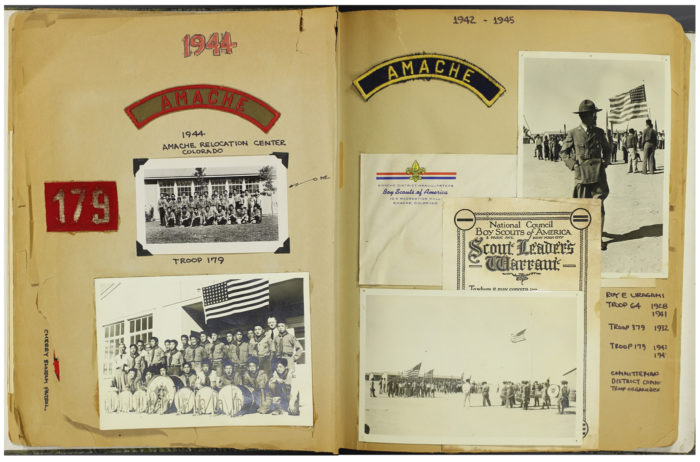
Japanese American National Museum, Gift of Robert and Rumi Uragami (2003.86.1)
Click to open full-size image in new tab.This object is part of the story Scouts in Camp, which is about Identity.
These are two pages from a 73-page scrapbook documenting three generations of boy scouting in a Japanese American family. The scrapbook was made by Bob Uragami, whose father, Roy, was the first to become involved with scouting; Roy was followed by Bob, and later Bob’s son, Tim.
Look closely at these two pages.
- What do you recognize?
- What things do you wonder about?
- Where were these items used and when were these photographs taken?
- As you look at the photographs, what stands out to you?
- Why do you think Bob decided to include these specific photographs and mementos in his scrapbook?
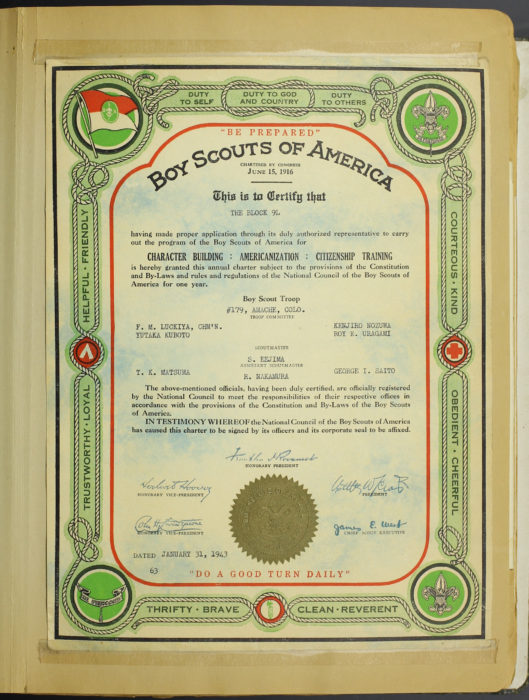
Japanese American National Museum, Gift of Robert and Rumi Uragami (2003.86.1)
Click to open full-size image in new tab.This object is part of the story Scouts in Camp, which is about Identity.
This Boy Scouts of America certificate was given to the Boy Scout troop of Japanese Americans incarcerated at Amache, Colorado. Look closely at the text and designs on this certificate.
- How would you describe the overall tone of this certificate?
- Which words stand out to you?
- How would you have felt if you received this certificate from the Boy Scouts of America while you were imprisoned by the US government?
- How might words such as “duty to country” and “Americanization” feel different to the members of this troop under the conditions in which they lived?
Bob Uragami video interview, Japanese American National Museum
Click to open full-size image in new tab.This object is part of the story Scouts in Camp, which is about Identity.
In this video, Bob Uragami speaks about the drum that was used by his Boy Scout troop while incarcerated at Amache. The drum can also be seen in one of the images in the scrapbook. As you watch this video, consider what Mr. Uragami says about the flags depicted on the drum.
When he refers to the “meatball,” he is using a nickname for the Japanese flag, which has one large circle on it.
- How does the story about the flags reflect the identity of this group of Boy Scouts?
- How does the story about the burial suit reflect the identity of Mr. Uragami’s father?

Japanese American National Museum, Gift of Robert and Rumi Uragami (99.2.8B)
Click to open full-size image in new tab.This object is part of the story Scouts in Camp, which is about Identity.
- What do you see depicted in this image?
- Who do you think the man in the foreground is?
- Where do you think this photograph was taken?
- What evidence in the photograph helps you draw these conclusions?
This photograph was taken at Amache Concentration Camp. Roy Uragami, the father of Bob Uragami, is pictured in his uniform in the foreground.
- How would you describe Roy Uragami’s expression?
- What thoughts might be going through his head at this moment?
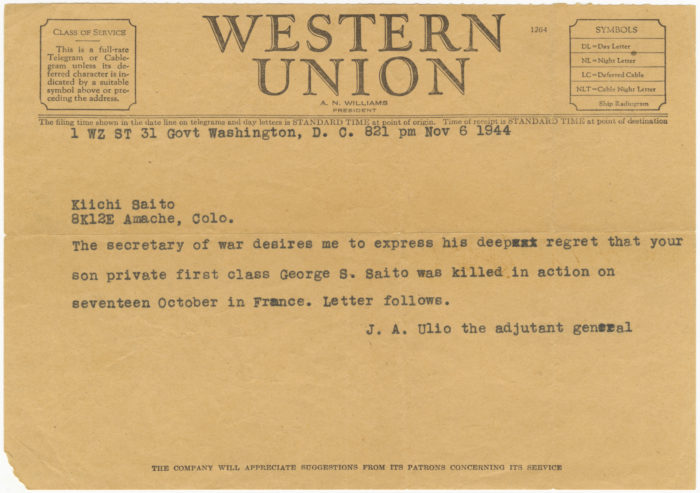
Japanese American National Museum, Gift of Mary Saito Tominaga (94.49.33)
Click to open full-size image in new tab.This object is part of the story Telegram to a Father, which is about Loyalty.
Read this document closely.
This is a telegram to Kiichi Saito. Three of Mr. Saito’s sons served in the United States Army during World War II including his son George, who is referenced in this telegram.
- Where was Mr. Saito living at the time he received this telegram?
- How would you describe the tone of this message?
- What questions do you have after reading this document?
Mary Saito Tominaga and Kazuo Saito video interview (November 2, 2010), Japanese American National Museum
Click to open full-size image in new tab.This object is part of the story Telegram to a Father, which is about Loyalty.
Watch this video of George Saito’s brother Kazuo and sister, Mary.
- Based on what they say about him in this clip, why do you think George decided to join the army?
- What can you gather about George from this clip? What type of person was he?
- Where was the Saito family living when George left to join the army?
- Did you notice the photograph of George and his brothers Calvin and Shozo? How are they all dressed in the photograph?
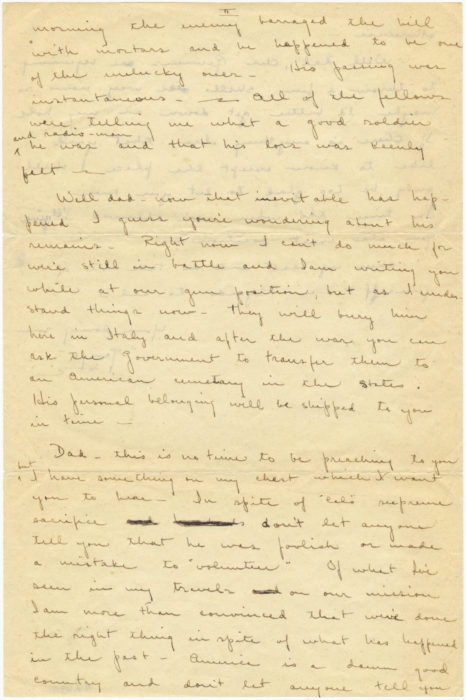
Japanese American National Museum, Gift of Mary Saito Tominaga (94.49.41)
Click to open full-size image in new tab.This object is part of the story Telegram to a Father, which is about Loyalty.
In 1944, while attacking a hill in Italy, George’s younger brother Calvin, who was also serving in the army, was struck and killed. This is from a letter George sent home to console his grief-stricken father.
Dad—this is no time to be preaching to you but I have something on my chest which I want you to hear In spite of Cal’s supreme sacrifice, don’t let anyone tell you that he was foolish or made a mistake to “volunteer.” Of what I’ve seen in my travels, on our mission, I am more than convinced that we’ve done the right thing in spite of what has happened in the past. America is a damn good country and don’t let anyone tell you otherwise.
– George Saito, letter to his father, July 11, 1944
- What do you think is the main message George has for his father?
- If you were in George’s position, do you think you would share his sentiments? Why or why not?
- Why do you think George felt it necessary to write these words?
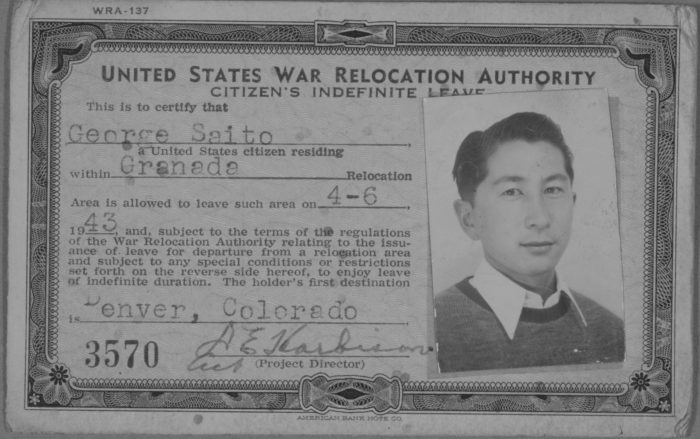
Japanese American National Museum, Gift of Mary Saito Tominaga (94.6.77)
Click to open full-size image in new tab.This object is part of the story Telegram to a Father, which is about Loyalty.
- Does this document give any clue as to who George Saito is?
- Does he look like a young man or an older man?
- What country is he a citizen of?
- What might prompt a government to monitor its citizens in this way?
- At the time this document was issued, where was George residing?
- Does such a document make you question the rights and limitations of an American citizen?
This document is George’s indefinite leave card, issued by the government as a way to monitor any subversive behavior in its American-born citizens of Japanese ancestry. This card gave George permission to leave Amache concentration camp. Soon after its issuance, George enlisted in the United States Army and served in the segregated 442nd RCT in Europe.
